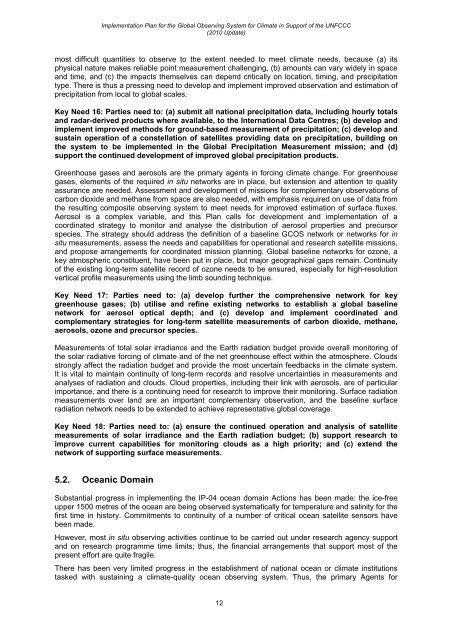GCOS Implementation Plan - WMO
GCOS Implementation Plan - WMO
GCOS Implementation Plan - WMO
Create successful ePaper yourself
Turn your PDF publications into a flip-book with our unique Google optimized e-Paper software.
<strong>Implementation</strong> <strong>Plan</strong> for the Global Observing System for Climate in Support of the UNFCCC<br />
(2010 Update)<br />
most difficult quantities to observe to the extent needed to meet climate needs, because (a) its<br />
physical nature makes reliable point measurement challenging, (b) amounts can vary widely in space<br />
and time, and (c) the impacts themselves can depend critically on location, timing, and precipitation<br />
type. There is thus a pressing need to develop and implement improved observation and estimation of<br />
precipitation from local to global scales.<br />
Key Need 16: Parties need to: (a) submit all national precipitation data, including hourly totals<br />
and radar-derived products where available, to the International Data Centres; (b) develop and<br />
implement improved methods for ground-based measurement of precipitation; (c) develop and<br />
sustain operation of a constellation of satellites providing data on precipitation, building on<br />
the system to be implemented in the Global Precipitation Measurement mission; and (d)<br />
support the continued development of improved global precipitation products.<br />
Greenhouse gases and aerosols are the primary agents in forcing climate change. For greenhouse<br />
gases, elements of the required in situ networks are in place, but extension and attention to quality<br />
assurance are needed. Assessment and development of missions for complementary observations of<br />
carbon dioxide and methane from space are also needed, with emphasis required on use of data from<br />
the resulting composite observing system to meet needs for improved estimation of surface fluxes.<br />
Aerosol is a complex variable, and this <strong>Plan</strong> calls for development and implementation of a<br />
coordinated strategy to monitor and analyse the distribution of aerosol properties and precursor<br />
species. The strategy should address the definition of a baseline <strong>GCOS</strong> network or networks for in<br />
situ measurements, assess the needs and capabilities for operational and research satellite missions,<br />
and propose arrangements for coordinated mission planning. Global baseline networks for ozone, a<br />
key atmospheric constituent, have been put in place, but major geographical gaps remain. Continuity<br />
of the existing long-term satellite record of ozone needs to be ensured, especially for high-resolution<br />
vertical profile measurements using the limb sounding technique.<br />
Key Need 17: Parties need to: (a) develop further the comprehensive network for key<br />
greenhouse gases; (b) utilise and refine existing networks to establish a global baseline<br />
network for aerosol optical depth; and (c) develop and implement coordinated and<br />
complementary strategies for long-term satellite measurements of carbon dioxide, methane,<br />
aerosols, ozone and precursor species.<br />
Measurements of total solar irradiance and the Earth radiation budget provide overall monitoring of<br />
the solar radiative forcing of climate and of the net greenhouse effect within the atmosphere. Clouds<br />
strongly affect the radiation budget and provide the most uncertain feedbacks in the climate system.<br />
It is vital to maintain continuity of long-term records and resolve uncertainties in measurements and<br />
analyses of radiation and clouds. Cloud properties, including their link with aerosols, are of particular<br />
importance, and there is a continuing need for research to improve their monitoring. Surface radiation<br />
measurements over land are an important complementary observation, and the baseline surface<br />
radiation network needs to be extended to achieve representative global coverage.<br />
Key Need 18: Parties need to: (a) ensure the continued operation and analysis of satellite<br />
measurements of solar irradiance and the Earth radiation budget; (b) support research to<br />
improve current capabilities for monitoring clouds as a high priority; and (c) extend the<br />
network of supporting surface measurements.<br />
5.2. Oceanic Domain<br />
Substantial progress in implementing the IP-04 ocean domain Actions has been made: the ice-free<br />
upper 1500 metres of the ocean are being observed systematically for temperature and salinity for the<br />
first time in history. Commitments to continuity of a number of critical ocean satellite sensors have<br />
been made.<br />
However, most in situ observing activities continue to be carried out under research agency support<br />
and on research programme time limits; thus, the financial arrangements that support most of the<br />
present effort are quite fragile.<br />
There has been very limited progress in the establishment of national ocean or climate institutions<br />
tasked with sustaining a climate-quality ocean observing system. Thus, the primary Agents for<br />
12
















